Welcome back, friends and readers! This month, we look at some great 8- and 16-bit titles that are sure to keep your thumbs twitching and your adrenaline pumping! Sit back, relax, and see what our staff and readers have been playing all April long!
Shinobi (Game Gear) By Ken Horowitz
 Oh dear lord, what have I been missing? I never owned a Game Gear back in the day, and while I was aware that the Shinobi series had two installments on the machine, I never got around to actually playing them. Now that I possess one of Sega’s underrated little handhelds, I finally have a chance to rectify that mistake. After playing the first game, I wonder how I neglected this series for so long! The graphics are great, the sound is awesome, and the gameplay is pure Shinobi goodness. The difficulty spikes in certain places, but I can live with that. It’s taken me a few decades, but I’ve finally gotten around to learning what many fans have known since 1991. This game rocks! Do yourself a favor when you play it: hook your Game Gear up to some external speakers or use some quality headphones. The internal speaker doesn’t do Yuzo Koshiro’s remixed soundtrack any justice. Now, on to Silent Fury!
Oh dear lord, what have I been missing? I never owned a Game Gear back in the day, and while I was aware that the Shinobi series had two installments on the machine, I never got around to actually playing them. Now that I possess one of Sega’s underrated little handhelds, I finally have a chance to rectify that mistake. After playing the first game, I wonder how I neglected this series for so long! The graphics are great, the sound is awesome, and the gameplay is pure Shinobi goodness. The difficulty spikes in certain places, but I can live with that. It’s taken me a few decades, but I’ve finally gotten around to learning what many fans have known since 1991. This game rocks! Do yourself a favor when you play it: hook your Game Gear up to some external speakers or use some quality headphones. The internal speaker doesn’t do Yuzo Koshiro’s remixed soundtrack any justice. Now, on to Silent Fury!
Growl By Joseph C.
When it comes to beat ’em ups, I am always interested when I find out about one I’ve never played. This is particularly so for the Mega Drive because I am pretty sure I’ve played most of them. I only recently found out that Growl was available on the Mega Drive, and this isn’t surprising since I was only vaguely familiar with the arcade game. Obviously, my excitement on finding out about this port was short lived, as the review on Sega-16 can well attest.
The first thing that struck me about Growl is just how much less there must have been to worry about in the early ‘90s. I don’t want to belittle the problem of animal poaching, but it seems like an odd concept for a game when even puzzle games today have the fate of the world hanging on how you move some blocks. So, a game based around Indiana Jones wannabes beating the hell out of cartoonishly evil poachers is stranger today than it would have been at the time. It’s so odd that it makes the twist at the end (which I won’t spoil), seem like a belated return to normalcy.
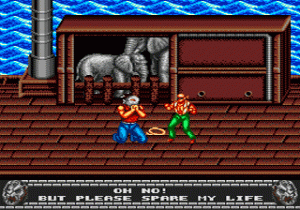 Unfortunately, as I found out a few minutes after pressing start, the concept is about the only endearing aspect of the Mega Drive port. I can’t speak for the arcade version, but this game is a let down on multiple levels. The first which must be stressed is that a beat-’em-up, as a rule, should always support two players. This doesn’t mean a game can’t be good without this, but two-player support can generally only improve a game. While the arcade version supported up to four players, this only supports one. The next problem is the gameplay itself which is barely competent. There are very few moves open to the player, and I found the hit detection to be really off. Luckily, this is also so for the enemies whose blows failed to connect almost often as mine failed to. Then, there is the way great clusters of identical enemies are sent at once. I eventually found myself jump kicking everything, which ended up being just as effective against bosses as with regular enemies.
Unfortunately, as I found out a few minutes after pressing start, the concept is about the only endearing aspect of the Mega Drive port. I can’t speak for the arcade version, but this game is a let down on multiple levels. The first which must be stressed is that a beat-’em-up, as a rule, should always support two players. This doesn’t mean a game can’t be good without this, but two-player support can generally only improve a game. While the arcade version supported up to four players, this only supports one. The next problem is the gameplay itself which is barely competent. There are very few moves open to the player, and I found the hit detection to be really off. Luckily, this is also so for the enemies whose blows failed to connect almost often as mine failed to. Then, there is the way great clusters of identical enemies are sent at once. I eventually found myself jump kicking everything, which ended up being just as effective against bosses as with regular enemies.
Despite these control issues, I didn’t have much time to get annoyed as it is a very short game. I managed to get through to the end my very first time playing, despite what I considered a poor performance on my part. Although it was limited, I will add that it was entertaining the way rescued animals would sometimes join you to attack the poachers.
If I’d rented it back in the early ’90s, I think I would have found it enjoyable enough for a weekend despite its limitations. But whether now or going back in time, I’d definitely caution against anyone spending any more than a fraction of its retail cost on the game. This is strictly one for collectors to buy and the curious to try.
Streets of Rage 2 By Cleeg
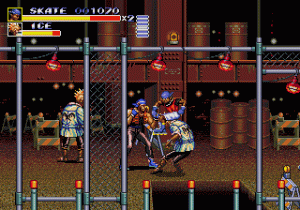 I’ve been playing a bit of Streets Of Rage II this month to get me in the mood for the upcoming new brawler Paprium. I never managed to complete it: Until now! I got through to the end using Blaze Fielding playing on my GPD XD (save states NOT used) while I was on holiday, so I do feel a little dirty as if I was somehow cheating on my MD back home. What happens in Whitby…
I’ve been playing a bit of Streets Of Rage II this month to get me in the mood for the upcoming new brawler Paprium. I never managed to complete it: Until now! I got through to the end using Blaze Fielding playing on my GPD XD (save states NOT used) while I was on holiday, so I do feel a little dirty as if I was somehow cheating on my MD back home. What happens in Whitby…
The music is just something else, the gameplay well balanced and frantic in all the right places and much fairer than its prequel which had me tearing my hair out at times. Graphics are excellent, with some nice panning effects in particular. The only aspect of this game that I didn’t care so much for were some of the environments, which aren’t very “streetish” as the title suggests. I get that this is to provide variety, but I think the first game nailed the vibe much better.
If you haven’t played this game you really should, especially if you like this genre.
Tale Spin By David Dyne
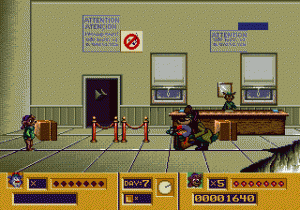 Last month I played through the Game Gear version of Tale Spin and decided to give the Genesis one another try. Playing it in single-player mode on Easy difficulty seems to be the best way to keep your sanity intact, as the Medium and Hard difficulties are skewed more towards two-player modes only. Single players need not apply unless you want to be driven bonkers in the process.
Last month I played through the Game Gear version of Tale Spin and decided to give the Genesis one another try. Playing it in single-player mode on Easy difficulty seems to be the best way to keep your sanity intact, as the Medium and Hard difficulties are skewed more towards two-player modes only. Single players need not apply unless you want to be driven bonkers in the process.
What else is there to say about Tale Spin? Not a whole lot, other than that despite the game’s balancing issues, I still enjoy it even though I’ll never beat the game on the higher difficulty settings. Twenty-five years ago when you could count the number of games you owned on one hand, I’d be much more inclined to spend the time trying to master this one on all difficulty settings. Now I’ll just count this one as finished for now with an asterisk and move onto another title.
Road Rash By Paige
I’ve been playing several games the past few weeks, but the one that has held my attention most is Road Rash. I played this game a lot as a kid, having gotten it way back in the mid- to late-’90s, with various degrees of success. Numerous times, I wrecked my bike or got busted by the cops too often and received a game over. A couple of times, I managed to qualify (placed fourth or better) in all five races and move on to level two, and on more than once occasion I spent who-knows-how-long playing the same race over and over again in an attempt to purchase the most expensive (and presumably best) bike in the game—the Diablo 1000—and one time I actually did!
But despite all my half-hearted attempts to get through this game, I always had a blast every time I played. I mean, what kid wouldn’t enjoy a game that gave you the opportunity to punch and kick your fellow racers off their motorcycles? But my favorite part of the whole game was right before a race, when one of the game’s characters would have a sentence or two to say to you. Sometimes they would be helpful, sometimes they would say something kind of humorous, and if you were aggressive toward them in the previous race they’d be downright threatening! It’s a bit embarrassing to admit now, but at one point I was convinced there was a sort of implied romantic thing between the player’s character and Natasha, and I did everything in my power to make sure no harm came her way, thinking that the player somehow earned brownie points by doing so (I was nine, okay?).
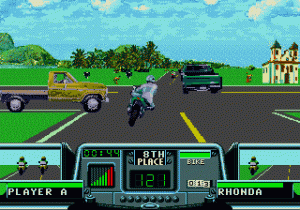 In any case, I had never made any considerable progress. Generally speaking, even though I love this game I never quite had the patience to play it, except when I was trying to scrounge up the cash for the mighty Diablo 1000. I would get discouraged too easily if I kept veering into oncoming traffic or slamming into roadside obstacles. In other words, I guess I thought the game was too hard (again, I was nine). But here we are, about 20 years later, and I’ve decided to give Road Rash the honest playthrough it certainly deserves.
In any case, I had never made any considerable progress. Generally speaking, even though I love this game I never quite had the patience to play it, except when I was trying to scrounge up the cash for the mighty Diablo 1000. I would get discouraged too easily if I kept veering into oncoming traffic or slamming into roadside obstacles. In other words, I guess I thought the game was too hard (again, I was nine). But here we are, about 20 years later, and I’ve decided to give Road Rash the honest playthrough it certainly deserves.
Progress was great for the first two levels. I managed to qualify in all the races and quickly amassed the money to buy the next-best bike, even placing first a few times. Level three, which I had never been to before, was much more difficult (the races now last around six minutes) and I had to redo some races numerous times to qualify, but I was ecstatic to finally earn my place to move on to level four.
And… I was stuck. My bike was unfit for the grueling races (it’s the third most expensive one, coming in at $14K), and so I made the decision to forgo purchasing the second most expensive bike (worth $20K) to start saving up the $25K for the Diablo 1000. This, however, proved impossible for me. When I wasn’t totaling my bike or getting fined by the cops, I was finishing somewhere around eighth place, netting only a few hundred dollars. Since the races now lasted upward of seven minutes (if I was lucky), it was pretty plain to see this was not an efficient way to make the money I needed. I was then left with two options: I could keep doing this anyway until I could buy the $20K bike, which would set me back considerably but would hopefully let me place better so I could make money a little faster; or I could scrap the game and start over, revisiting to my childhood strategy of playing some level one race over and over again until I could afford the Diablo 1000.
Two days ago, I went with the latter option.
All told, it took about an hour and a half to finally afford and purchase the Diablo 1000, and I couldn’t believe how fast it was! I ripped through the remaining level one races so quickly—my typical finish time went from just over two minutes 38 seconds to maybe 90 seconds total—and sometimes I was going so fast didn’t even realize I was in immediate danger until I after the hazard had been passed. Level two was also a breeze, and by the time I completed all five of its races I had yet to finish worse than first place.
I’m currently three races into level three, and this is the first time since I started over that I’ve been experiencing some trouble. I still qualify, but I don’t always finish first. I’m still faster than the other racers, but sometimes I get trapped in a group of them and they manage to throw me off my bike; I haven’t wrecked my motorcycle yet, though I have gotten busted by the cops after slamming into a tree. But I’ve also learned some tricks that so far seem to be the way to go: once I’m in first place, it’s not important to keep going at full speed—I really only need to go fast enough to stay ahead of whoever’s currently in second—and I’ve chosen to take a page out of Ikira’s book and not get involved in fights unless absolutely necessary.
Level four, I’m coming for you!
Aerobiz By Colton Ray
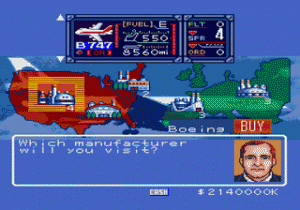 I’ve always been intrigued by the complexity and inventiveness of the KOEI lineup on the Genesis, but only recently have I taken the plunge into actually playing through their games. Last year, I played Genghis Khan II and found it very enjoyable after a steep learning curve. Aerobiz also has a learning curve but one that is surmountable with a read-through of the manual. You’re basically dropped straight into the world of international air travel, given a starting budget, and told to have at it, kid. You have a board of advisers that sometimes give advice, but for the most part, you’re free to succeed or fail, racing against the computer for the most profitable airline in the world. Your goals: link 22 cities, ferry 3500k passengers, and stay in the black. Due to the technological restraints of the time, many 16-bit games can feel limited and blocked-in; the freedom that Aerobiz allows in developing your personal business strategy is refreshing. My first run-through had many good and bad years; starting in 1983, it took me until 1995 to complete my goals. It’s not for everybody, but for this retro gamer, Aerobiz delivers lots of strategy and satisfaction.
I’ve always been intrigued by the complexity and inventiveness of the KOEI lineup on the Genesis, but only recently have I taken the plunge into actually playing through their games. Last year, I played Genghis Khan II and found it very enjoyable after a steep learning curve. Aerobiz also has a learning curve but one that is surmountable with a read-through of the manual. You’re basically dropped straight into the world of international air travel, given a starting budget, and told to have at it, kid. You have a board of advisers that sometimes give advice, but for the most part, you’re free to succeed or fail, racing against the computer for the most profitable airline in the world. Your goals: link 22 cities, ferry 3500k passengers, and stay in the black. Due to the technological restraints of the time, many 16-bit games can feel limited and blocked-in; the freedom that Aerobiz allows in developing your personal business strategy is refreshing. My first run-through had many good and bad years; starting in 1983, it took me until 1995 to complete my goals. It’s not for everybody, but for this retro gamer, Aerobiz delivers lots of strategy and satisfaction.

Recent Comments